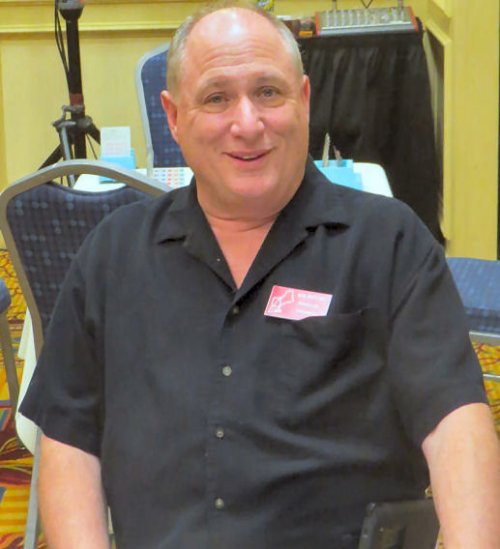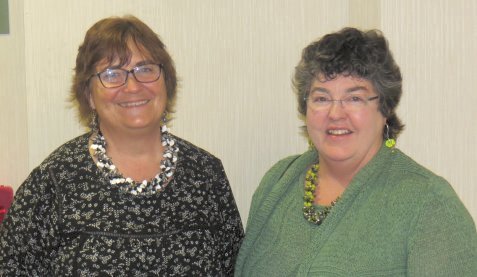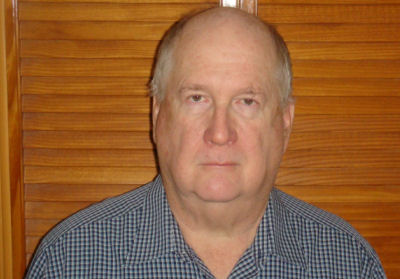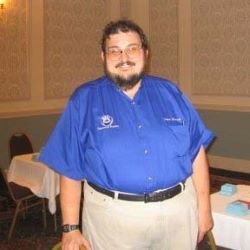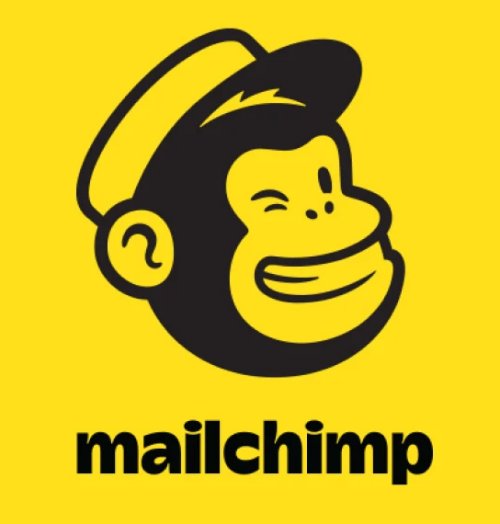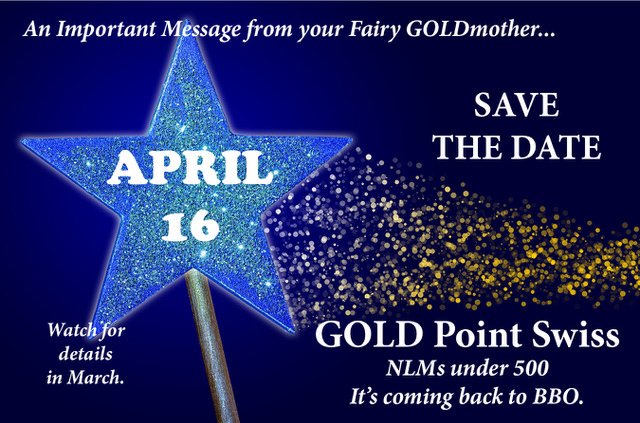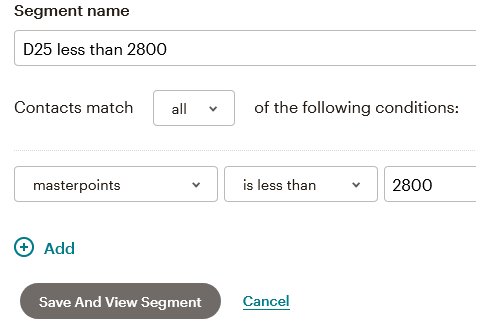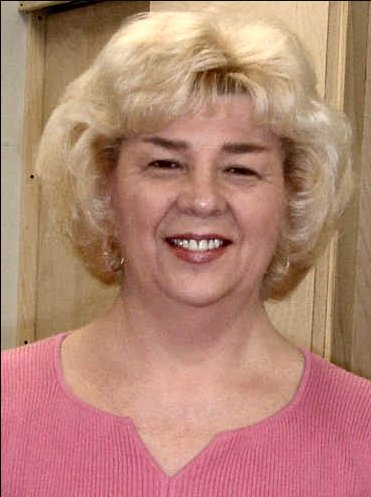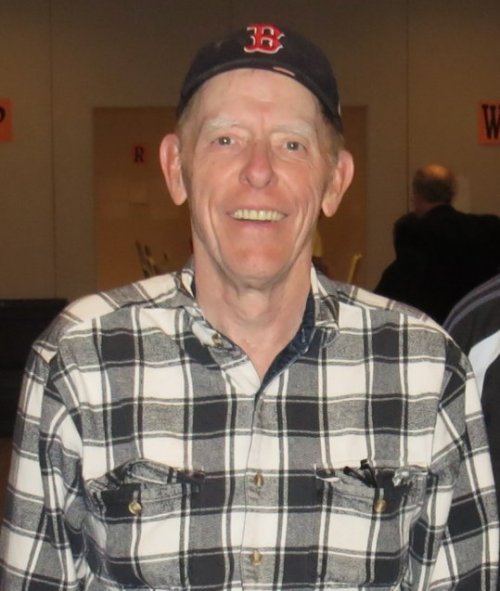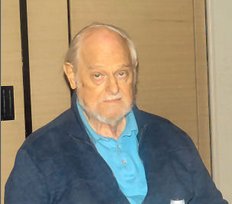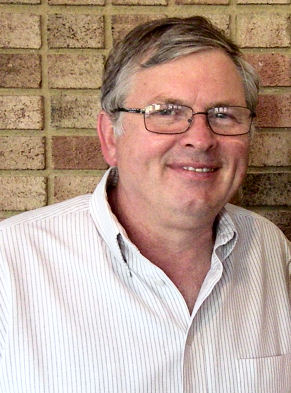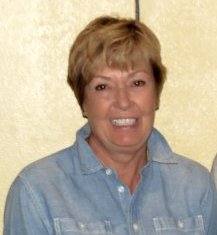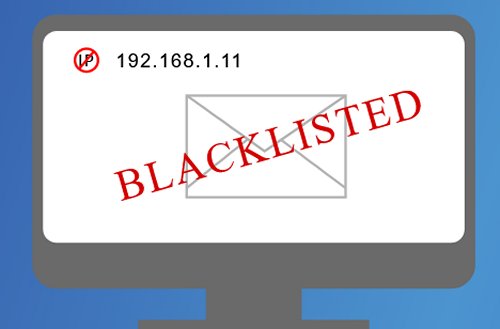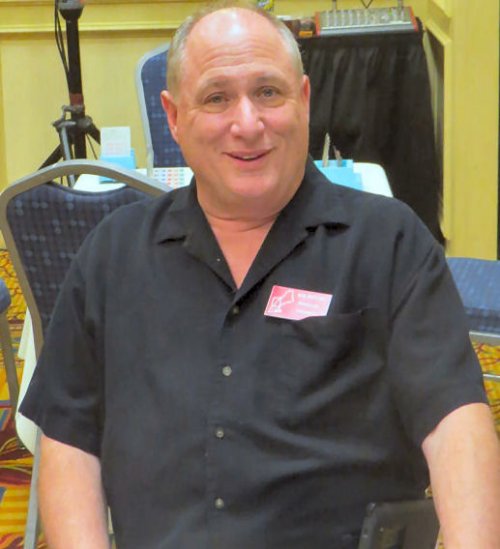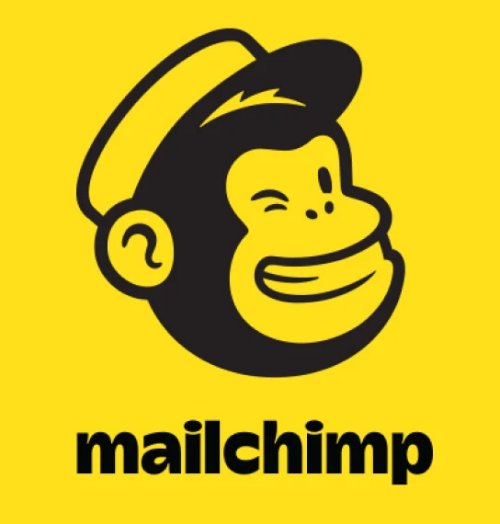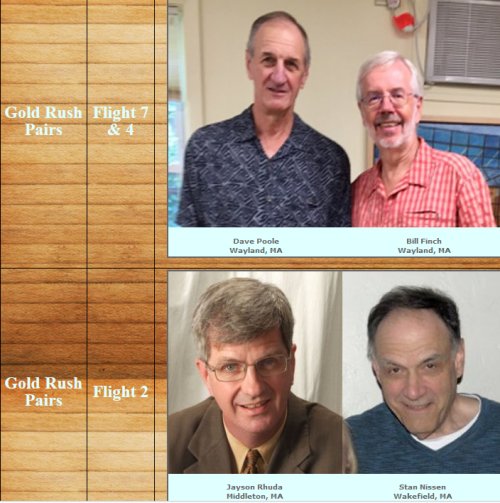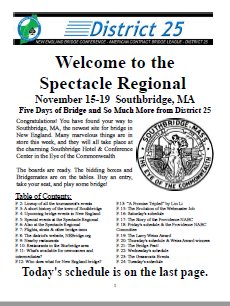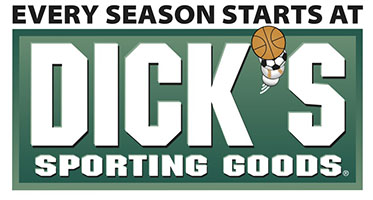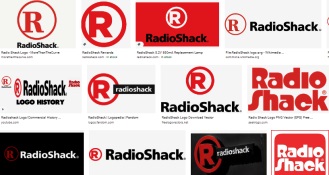Eighteen months of torture. Continue reading
This entry, like the process that it describes, is absurdly long. In fact, it is much longer than it looks because it has links to a large number of documents that have more details. I don’t expect anyone to read this entry. I did it out of a combination of determination to leave nothing out and a sense of catharsis.
I really loved my job as webmaster for District 25 and all of the other functions that I had added (as described here). The only aspect of it that I found tiresome was the assembling of photos for the Winners Boards. I had decided unilaterally that I would no longer do that in 2020, but I was still enthusiastic about everything else that I did.
The pandemic struck New England in March of 2020. The game that I loved that involved card tables, chairs, playing cards, bidding boxes, human beings, and conversation vanished almost overnight. Some people enjoyed, or at least tolerated, playing on the Internet, but I did not like it at all. It did not seem like bridge to me.
At first I enjoyed my new life of leisure. As I described here, I started walking a lot, occasionally traversing as much as ten miles per day. I also read books much more frequently than I had previously, and I invented a method for the people who had played together in Simsbury to describe what they were doing in the new world of isolation. I discovered that a very large number of operas were available free on YouTube. I downloaded a free program, MP3Studio, to make mp3 files that I could download to my mp3 player. So, I could carry forty or fifty operas in my pocket.
In June of 2020 my schedule changed dramatically. I undertook the gargantuan 1948 Project that is described here. From that point on I sat in front of the computer for several hours per day writing and researching, and the more time that I spent on the project the larger that it grew.
In the summer of 2021 my friend and boss in District 25, Bob Bertoni, died after a long and debilitating illness. At that point almost all of the people with whom I had enjoyed working for so many years were no longer involved in the district’s leadership. Moreover, the ACBL had taken strong measures to promote online play as an alternative to real bridge. It seemed almost certain to me that the game that I knew was doomed.
The Hartford Bridge Club tentatively reopened in the summer of 2021, and Sally Kirtley and I figured out a way to schedule games of the Simsbury Bridge Club. However, no tournaments were held in New England except the poorly attended sectional in December sponsored by the Eastern Mass Bridge Association (EMBA). At the time I was a member of both the district’s Executive Committee and the Tournament Scheduling Committee. Both held occasional Zoom meetings. I wrote this about the decision-making:
I have been on the scheduling committee for a few years, but two crucial online meetings were held in the winter on Wednesday evening, the one time that I am committed to play at a very small club. Evidently a lot of decisions about the three tournaments in 2022 were made at those meetings or at the one in May, during which I was in Europe.
In the last quarter of 2021 I notified the Executive Committee that I intended to resign my positions tied to the webmaster job at the end of 2022. I modeled my decision on this with how Helen Pawlowski handled the termination of her long tenure as the district’s tournament manager. She had given a year’s notice that she was leaving. A committee was promptly formed, people applied for the job, Sally Kirtley was chosen, and Helen showed her the ropes at several tournaments.
After I resigned not much happened for several months. When I had started in 2013, absolutely nothing was documented in writing. By contrast, I had already produced on NEBridge.org about forty web pages that documented everything that I did in every area. Thereafter, I spent an enormous amount of time making sure that each of these pages was up to date. They can all be reached from here.
The oldest email that I could find about the subject of the transition was dated November 30, 2021. In It Curtis Barton, the president, asked me, “Do you have a candidate to replace you?”
The one thing that I did not want to do was to become an active participant in the search for my replacement(s). I thought that it was incumbent upon the people who would be running the district going forward to determine which of those functions was still important and to find people who were willing and able to perform them. I did not want to prejudice this effort with my own ideas.
I felt that I had done everything that I could to smooth the process. When I was chosen to be the webmaster, Bob Bertoni had assumed the responsibility of finding someone for the job, mostly because he was the only person who knew how the site worked, and there was no documentation whatsoever. In the intervening years had thoroughly documented how my various functions were performed.
So, on December 31 I sent the following reply with four attachments.
As promised, I have produced and attached documents that outline the duties of four functions that I currently perform:
• Webmaster
• Database Manager
• Email Manager (MailChimp)
• Bulletin Editor (printed, online, and Day 1).Someone needs to decide on who, if anyone, should perform these functions in 2023 and following. The Database Manager and Email Manager are not official positions.
I am not sure if the Communications Committee still officially exists, but I formerly set the agenda for and presided over its meetings.
I also have been composing a high percentage of the emails used to promote tournaments. Whoever assumes that function in 2023 and following will need to work with the Database Manager on the selection criteria to be used and the Email Manager on the format to be used for text and images.
The four attachments to the email have been posted on Wavada.org: Webmaster, Database, Email, Bulletin.
At some point Gary Peterson, who was a Tournament Director for the ACBL, expressed an interest in becoming the webmaster. He negotiated with Curtis about how he would be compensated for his efforts. I was not privy to those exchanges. My assumption was that he would be responsible only for maintaining the website. I suspect that Curtis expected him to do much more than that. It is also possible that Curtis only glanced at my write-up.
In April of 2022 I sent all the members of the Executive Committee an email that detailed open issues in areas that I was involved. I attached to this email a spreadsheet that served as the index to the documentation pages.
It has been a long time since I made a report, but I have been keeping a list of developments and issues.
Website: 1) I removed four items from the main menu in the left column that appears on every page of the site. Three of them I moved to the “Archive” tab: District Director Info, District Director Report, and Learn from the Experts. The other one was a link to the ACBL’s Partnership Desk, which the ACBL’s webmaster told me is no longer supported.
2) There are three issues. The Tournament Location option is a custom program that uses a list of the district’s tournaments to create a map. For a while it was broken, but Megahertz fixed it. I removed Cromwell and Sturbridge. I added Providence and Marlborough. I left Mansfield and Hyannis on, but added notes that they were canceled for 2022. This will need to be maintained (using the “Clubs” option in the admin section) when the 2023 schedule is set.
The second issue is the banner, which currently says “Exciting New Event Schedules for 0-2500 –Click Here for Tournaments”. It links the NEBridge.org calendar. I don’t know how to change it. Bob always did this. We should probably be highlighting Providence. After that, I don’t know.
The third issue involves reports from the Regional Director. The DD reports had their own custom option. Should I add the RD reports to this program (and bring it back from the Archive)? Should I create a new tab for RD reports? They are now emailed to members; posting them on the website is less critical than it was ten years ago.
3) The list of winners of NABC and NABC+ events has not been updated since 2019. The source of data was lists provided by the DD. I have not received any such lists since December 2019. What should the policy be for the future?
4) I have decided not to post Winners Boards (photos) for the 2022 tournaments. It is a lot of work, and I won’t be attending one of the three events. If someone else wants to take the photos of winners and solicit photos from the ones that were missed, I will post them. However, I don’t want to do this if the percentage of missing photos is high.
I also decided not to award the Best in Class prizes in 2022. With only three events, all in the eastern half of the district, it did not seem worthwhile to me.
5) Someone should check the conditions of contest on the website. I don’t think that the first five documents on the Conditions of Contest tab have been checked in a long time.
Database: 1) A decision should be made about whether the MySQL database, which I maintain on both my iPower account and my local server, will be used in 2023. If not, a suitable substitute to be used as the basis for emails should be found. The current database includes all ACBL members–active and inactive, living and dead–since 2014. It also contains pretty good records of who attended D25 and NABC tournaments since then. It also has a history of achievement of ranks of D25 members and points by month of everyone.
2) In the past I have received .LZH files from Keith Wells at the ACBL to use as the basis for the attendance (at tournaments) table. He did not respond to my last request. Does anyone know if he still works for the ACBL? If not, from whom could I get these files. I used the attendance tables both for targeted emails and for the attendance breakdowns after tournaments.
Email: I currently create the emails by using a text editor on my PC to write HTML statements. I then use the “Code your own” method to paste the code into MailChimp. As I was writing up the documentation for this process it occurred to me that it will probably be very difficult to find someone is who is both willing and able to do this. MailChimp has a lot of templates for emailing that would presumably be much easier to use, but I have never investigated them because I already knew how to make the emails look exactly as I wanted them to.
If templates are used exclusively, it will affect Sue Miguel’s emails. She sends me an email that looks the way she wants it. I extract the HTML from it and then post it using the “Code your own” method.
Bulletins: I was told that there will be neither a printed nor an online bulletin for the Gala. Eventually decisions should be made about the other two tournaments in 2022.
Documentation: I have documented almost everything that I do in “pages” on NEBridge.org. I have created a spreadsheet that serves as an index to these pages. I have attached a pdf of it to this document. I am confident that by later in the year it will be complete and as accurate as I can make it. I suspect that the person or persons who do these tasks will want to simplify the processes, but whatever process is used, it should be documented, and I think that the format that I chose is optimal, since anyone can see the most current version.
The starting page is 342. It can be accessed with the URL NEBridge.org/pages/342. All pages can be reached from there, but if you want to look at a particular page, the easiest way is to key in NEBridge.org/pages/ppp in your browser, where ppp is the three-digit page number on the spreadsheet for the index.
Communications Committee: I think that consideration should be given to restarting the CommComm in 2023 or maybe sooner. I am willing to serve on it, but I don’t want to be chairman in 2023.
Two regional bridge tournaments in New England in 2021 had been canceled because of the pandemic. The Presidential Regional that was scheduled for February 2022 was also canceled because no suitable site in the southwestern part of the district was available. A new event, which was called the Gala, was scheduled for late May, which was the time that my wife Sue and I had planned to take a cruise in Europe1. We had deliberately chosen the second half of May because, in all the years that I had been going to tournaments, the district had never held an event then.
Meanwhile Curtis was trying to figure out if, as an ACBL Employee, Gary would be allowed to be both webmaster for the district. Curtis finally determined that he could. In early July he asked me to set up a Zoom meeting with Gary, Peter Marcus2, and himself. I told him that I had no idea how to set up a Zoom meeting, and that I was very busy at the time.
The second half of July was dominated by the Summer NABC that was held in Providence. Curtis decided that he needed two people to replace me. He offered one of the jobs to Gary in this email sent on August 10.
The other candidate wasn’t interested. That puts you (Gary) back where you’ve been – my choice for NEBC Database and NEBridge.org Webmaster. If you accept the position we will discuss compensation (Mike gets free plays and some other stuff – not too valuable for you) on a per tournament basis.
I suggest you contact Mike for his write-ups on the efforts. If you accept I will also begin the search for a Communications lead to supplement (not replace) existing efforts.
Communications Lead:
• Voting member of the TSC
• Cannot be an ACBL employee
• Essentially a volunteer position; may, in the future be compensated with free plays or similar consideration.
• This primarily a marketing function with technical considerations as agreed with the NEBC Database/NEBridge.org Webmaster
• Coordinates the electronic aspects of tournament advertising and execution
• Works with the Database/Webmaster
• Edits the Tournament Bulletin as required
• May use MailChimp email system to create messages as required.NEBC Database/NEBridge.org Webmaster
• Does not and cannot be a voting member of any NEBC Committee
• Can be an ACBL employee
• This is a compensated position on a “per tournament” basis
• Maintains the NEBC website
• Maintains the NEBridge.org database
• Works with the Communications Lead and Tournament Coordinator to maintain Calendar
This was by far the longest communication that I had ever received from Curtis. It appeared that some progress was being made. The fact that he was conflating the webmaster and database jobs was, of course, disconcerting. The webmaster job had gotten easier over the years. The database job was quite another matter.
This missive pretty much confirmed my notion that no one wanted to revive the Communication Committee. The “as required” appellation applied to the bulletin position was also ominous.
An email from Peter asserted about the database that “It might be work, it might cost money, but I think we really don’t want to abandon it.” Nobody ventured a different opinion. The question then became where the database would be kept. I did not want other people with administrative authority to sign on to Wavada.org.
I am not sure that my next contribution was helpful, but I did not want anyone to claim that I was not forthcoming about the difficulties.
Now that I think about it, iPower is not a critical element. Assuming that two copies of the database (one live and one for testing/backup/disaster recovery) are used, what are needed are two installations of WAMP (Windows, Apache, MySQL, php) or the equivalent. I used iPower for the live version because I already was using its server for other projects on my personal website, and there was a lot of capacity. WAMP is available as a free download for windows-based computers. iPower uses a UNIX version of the three products, but they do not charge extra for MySQL and php.
Mark Oettinger, the newly elected (sort of) vice-president of the district, suggested that Sue Miguel could do some of the work of the Communications Lead. No one objected.
Gary officially accepted the job of webmaster and indicated that he and I might be able to meet together at the Ocean State Regional in Warwick, RI, (documented here) scheduled for the end of the month. I responded with the following:
I have created a user profile for you for the admin section of NEBridge.org. The user ID is GaryP. After I send this email, I will send the password in a separate email.
I will be in Warwick for all five days. I will be attending the meetings of the Tournament Scheduling Committee and the Executive Committee. I will have the other evenings free. I will be pretty busy until then.
I have documented almost everything that I do on numbered pages (the ones that have the green menu on the left) within the NEBridge.org website. The starting page for all communications functions is #342. The starting page for webmaster functions is #85. The full URL’s are https://nebridge.org/pages/342/ and https://nebridge.org/pages/85/, respectively. The easiest way to get to them is to go to NEBridge.org, click on “Tournament Results” and change the /3/ to the page that you want. I have attached a spreadsheet that has all the page numbers.
There are wysiwyg tools for editing the numbered web page. It is also possible to enter HTML code. I resort to the latter when the former doesn’t provide what I want. The concepts are pretty straightforward. When I started in 2013 there was no documentation, and Bob Bertoni’s training session only lasted thirty minutes.
I am looking forward to meeting you in Warwick.
I introduced myself to Gary when I played in the side game, but I never met with him in the evening. I did meet Steve Ackerman, a player from Vermont. Mark Oettinger had recommended that I get him involved in the transition. I sent him essentially the same email.
In September Curtis sent Gary and me a short email asking whether I could teach them to use MailChimp. I did not envision either of them using it much, but here is what I responded.
MailChimp is not hard. I will set up a user ID for NEBPres and for NEBWeb. I will send the passwords in a separate email. The steps for using MailChimp are documented on NEBridge.org. I will provide training if necessary. I know nothing about using Zoom for training.
The big issue is what is going to happen to the MySQL database that is used for, among other things, populating the lists on MailChimp. The database currently resides on an iPower server on which I have leased space for about ten years. I am willing to give the php scripts that I have written to maintain the files to the district, but the database and the scripts somehow need to be copied to a server owned or leased by the district. That is unlikely to be an easy task. However, there is a great deal of other stuff on my website on iPower, and I don’t really want anyone else to have read/write access to it.
The other big issue is that Keith Wells, who is now a contractor for not an employee of the ACBL, has not answered any of my emails in five months. His last one said that he was still the person that I should contact in order to obtain the .LZH files used by the scripts that update the attendance table. On the advice of Tim Hill I sent an email in September to tournaments@acbl.org. The unsigned response, with a cc to Keith, said that Keith was still “at the ACBL”.
So, I have been unable to maintain the attendance table by my usual methods. Someone needs to decide whether it is still necessary for the district to maintain the attendance table, on which I formerly recorded who attended each regional and sectional in New England and each NABC. If not, it might not be worth the effort to continue using the MySQL database to keep a comprehensive roster of players, their advancement, their attendance, and a few other things. In that case the whole emailing strategy may need to be rethought. Maybe it could be done with spreadsheets or some other method. To my knowledge no other district goes to so much trouble to target emails.
It is possible to update the attendance table without the LZH files. The alternative method uses the “Master Point Winners” report in the posted results on the ACBL tournament schedule. However, 1) It is both kludgy and very time-consuming because there are no ACBL numbers, and 2) there is no way that I know of to account for people who earned no points at the tournament. So, I have been reluctant to resort to that method.
I am doing what I can to help the transition, but I don’t want to be the one who makes important decisions that affect how the mailings are done in 2023 and following.
The first sentence was a mistake. The way that new user profiles are created in MailChimp is to “invite” other people through an option in MailChimp. They then are sent an email from MailChimp that explains how new users can create their own profiles.
As of this writing in June of 2023, I have still not been able to gain access to the LZH files.
Shortly thereafter someone brought up the possibility of using the Pianola software that a third party had customized for the ACBL When the product was introduced several years earlier, I had looked into this and shared my low opinion of it with the members of the Executive Committee. I repeated those points for Curtis and Gary.
Addendum: The ACBL allows direct but very limited access to its active player database for emails, but there are several limitations that render this approach less effective in targeting. I have not investigated this approach recently, but the limitations that I remember are:
1) You must use Pianola. My understanding is that it does not support images, tables, font changes, and other tricks that I sometimes have used within messages. Both Sue and I use a lot of embedded images.
2) You can only access the records for a limited number of districts/units.
3) The format is, to say the least, unimaginative. It is black on grey.
4) I am uncertain of how much targeting can be done. I seriously doubt that one can target (as I did for NAP) based on the May 6 ACBL roster. I also feel certain that targeting based on attendance or zip code (Cape, for instance) is not possible.
5) The rate charged U126 is four times what we paid, and the last time I looked that rate is still available.
6) Access to the database can only be for the purpose of emailing. If you want to use it for some other purpose, you must keep your own files somehow.
7) I am not sure that Pianola has all the reporting tools that MailChimp offers. People who have complained to me about not receiving an email are sometimes surprised that MailChimp knows whether each email was delivered, whether it was opened, and whether any links were clicked on.
8) A small number of people have provided me, but not the ACBL with their email addresses.
9) I think that if someone unsubscribes on Pianola, they can no longer be reached. MailChimp has the same rule, but because we have lots of lists, we can control the effect. For example, if a club manager unsubscribed to the recent club mailing, he/she would still receive emails about tournaments, letters from the president, surveys, and other types of emails. On the other hand Pianola does support attachments, and MailChimp doesn’t. I have not found this to be much of a limitation, but if we did not have a website on which to post the attachment so that we could link to it, it would be.
Nobody mentioned Pianola for quite a while after that. Somehow someone got the idea that I would host the database for the district. On October 28 I wrote the following to Curtis:
I don’t host the database now. I pay $200 per year to iPower to host it. I know very little about hosting databases. The district could get an account with iPower or some other hosting service that supports MySQL and php and has a way to import databases and programming files. I contracted with iPower a long time ago. I don’t remember why I picked them.
I will help with migrating the database and the scripts over. I don’t really want to support the php scripts, but if you cannot find anyone who knows php, well … I would have to think about it.
If you are really asking me if I would agree to set up user ID’s for others on my iPower account, the answer is no. I have a great deal of other stuff on my account, and I have spent hundreds of hours on it.
So, the first decision is whether it is worth the effort to maintain a relational database. If the district cannot find a reliable source for getting the lzh files, I would be inclined to doubt it. The roster files, which are the source for most of my selections, can easily be downloaded from ACBL.org and then opened in Excel. Someone who is a wiz at spreadsheets could probably do the selections from the spreadsheets. The uploads to MailChimp require csv files, and spreadsheets could–after some slicing and dicing–be saved as csv files for that purpose.
When the above issue has been addressed, one other remains: How many lists on MailChimp will be used and reused? I suggest at least one for presidential communications, one for regional tournaments, one for NAP/GNT, one for clubs, and one for I/N. We now have a very large number of lists–one for every email (as Bob recommended). This has been feasible because the database has a field to flag players who have unsubscribed. I never select these people for any mailing promoting a tournament. Without that field I would need to reuse lists, as I sometimes do now for other types of emails.
If you decide to reuse the lists, you should add fields for masterpoints and rank description so that you can “segment” the lists as required for the email. This is the way that I handled the five emails promoting the 2022 NAP. The only problem is that someone would need to decide whether people who unsubscribed in response to those emails should also be unsubscribed from one of the other lists.
Curtis put the burden on Gary and Steve with a short reply: “We need someone to host our data base, and we need that someone now. You guys are the experts. Figure out what we need to do, and let’s get it done. “
Gary said that he was not a database engineer, but he was an “Excel weenie.” Steve set up a Dropbox for me and asked me to put the database and the php scripts in it. It took me most of a day to do this because a great deal of what is on Wavada.org is related to my blogs, journals, and other projects. Even after I culled those out, the remainder barely fit in the Dropbox, and the company that sponsored it kept sending me emails that I should upgrade my subscription.
Not much else happened until I wrote up the following summary on November 28:
General: All of the tasks have been documented on pages of NEBridge.org. The appearance of a few MailChimp screens has changed, but the work flow has not. All the documentation pages can be reached from https://nebridge.org/pages/342/.
Webmaster: I have given the credentials for the email redirecting to Gary Peterson. I have also set the emails for webmaster to redirect to his email account.
Action item: The ad on NEBridge.org for the ACBL online regional was still there today.
Database: Peter said that LZH files should now be available from ACBL somehow. If so, it is still probably a good idea to keep up the database if someone can learn how to maintain it. Those files can help with both targeted mailings and analysis of attendance at tournaments.
Action item: I will communicate with Peter about how to get the LZH files from the ACBL. When I do, I plan to upload all of the files for D25 sectionals and regionals in 2022 as well as the Providence NABC. I will then submit attendance reports for the Providence and Southbridge regionals and the Providence NABC to the Executive Committee members via email.
The current database is MySQL. The scripting language php is used for maintenance and reporting. I will create a copy of the database, the php scripts (including the Javascript and CSS), and a file of the SQL statements that I have used for lists and other purposes. I will then send them to wherever the new home is. I will also help with the migration as much as I can.
Action items: If the database is to be continued, 1) Who will maintain it and use SQL to select lists for mailings? 2) Where will the data and programs be stored? The system can actually be run on any Windows or Unix computer that has the free download WAMP or XAMP, but I chose to run it somewhere that provided support, which I have used four or five times per year. 3) Will the person who manages the database also manage MailChimp?
MailChimp: Policy decisions need to be made about how many lists will be used. The issue is how to handle “unsubscribes”. If a person unsubscribes from one list, should they simultaneously be unsubscribed from all? This will not happen automatically on MailChimp, but there is an “OK to email?” field on the database. The “actives” view of the players table, which I often used for selections for email lists, eliminates players with an N in this field or any other disqualifying information.
Action items: Who will manage the site? What will the workflow for new emails be? Will there be any reporting?
Email composition: Sue Miguel.
Bulletin Editor: I have copies of all the ones that I have done. I can send in odt or word format.
Action items: Is this worth doing? Who will do it? Will we resume using online bulletins?
This email generated a lengthy thread of responses. Curtis established the parameters:
Mike has done his usual great job in laying out the tasks ahead. I will take the Bulletin Editor3 task for Southbridge 2 (Mike: please send me the last Bulletin in Word format, please.)
Who will take on the rest of the effort? Please advise soonest.
I sent a copy of the Bulletin that I had created for the Optical Regional in 2022 to Curtis.
Curtis sent the following to Steve Ackerman and Neil Montague, who had expressed some interest in handling the emails:
We need a Mailchimp email expert (or maybe two!) to do the email parts of Mike’s current job. You both are great candidates for this. Any interest? Note: this will, in effect, make you a part of Sue’s marketing campaigns. It’s fun.4
Neil told Curtis that someone would need to show him how MailChimp worked. I invited him to create his own account and wrote:
MailChimp is not difficult. I have documented everything that I do in it on the NEBridge.org website, and the MailChimp site has very good FAQ’s and support when one needs it. I figured it out with no training whatever.
The bigger issue is whether to continue using the MySQL database as the source for creation of lists, and, if so, where it will reside.
Curtis wrote that Neil would officially become the MailChimp person and that Sue Miguel would compose the emails. Steve attempted to address the database issue.
As far as the database goes, I’ve taken a look at the LZH files that ACBLScor uses to update its database. Unfortunately, it only ACBL numbers and Points, not names and addresses. We would need more information than that to maintain the database. Another option is Pianola. I understand they are pricey, but it might be possible to work out a deal with them. https://www.pianola.net
I could not let that go unanswered.
I use four sources of information for the database: 1) Once a month (on about the 7th) I download the entire ACBL roster, which has almost all the census information on all active ACBL members; 2) The ACBL sends Webmaster@NEBridge.org a list of the players who advanced in rank during the previous month; 3) The LZH files for attendance at tournaments; 4) Individual maintenance when I learn something such as a nickname, a new email address, or an unsubscribe. Here is what I have for each player:
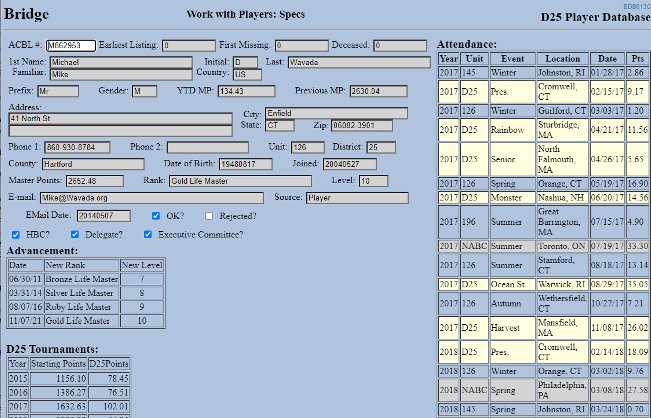
I described the problems with using the ACBL’s program that uses Pianola on a previous email. I will look for it and resend it if necessary.
This exchange generated an overly optimistic assessment by Mark Oettinger that showed praise on all the participants. No emails were exchanged in December except one from Curtis that asked me how much I would charge to continue to send out the emails “for one more month”. I said that I would certainly continue to do it if it was necessary. In actuality I sent out all of the emails in the first five months of 2023.
In January Neil wrote this to me: “I think I am supposed to send out the e-mails to the district via MailChimp. I have an account but since I’ve never really used it before, some quick help from you would be appreciated.” Neil was referring to the computer-generated emails sent by BridgeFinesse.com to players who had advanced in rank. I explained to him that he did not need to get involved in this process.
On February 11 Curtis notified me and the other participants that there would be a Zoom meeting to discuss the succession issues. He then wrote that Peter would send the invitation. At some point it was changed to an in-person meeting at the Presidential Regional in Southbridge. That gathering was never canceled, but it did not happen.
An email that I received from Sue Miguel got my goat. Here is what I sent to everyone on the Executive Committee.
In November of 2021 I gave notice that I did not want to be involved in precisely this type of thing–promotion of online gold point events, which I am convinced will be the death of regional tournaments. I have not seen one inch of progress in removing this responsibility.
I will send this out, but I AM PLEADING that the district relieve me of this responsibility. It makes me furious to be promoting this sort of thing.
Mike Wavada
From: Susan Miguel <suemiguel@cox.net>
Sent: Sunday, February 26, 2023 3:01 PM
To: Mike Wavada <Mike@Wavada.org>
Cc: Bussink-Jenkins <bussink-jenkins@comcast.net>; Peter Marcus <marcusp@att.net>; Gary Peterson <gspeterson7@gmail.com>
Subject: Save the GOLDEN DATE: April 16Mike: Please send to the world under 500
Gary: Please post on the homepage above Nashua
Curtis sent me an email that said that Sue should have sent the email to Neil instead of me. I sent out this email and several more over the course of the next few months.
Neil sent me an email on March 8 concerning an email that he had received from Paul Harris, the president of EMBA. He wanted to know the details of the district’s contract with MailChimp. I answered the inquiry with the following.
MailChimp charges D25 by the number of emails sent. Back in 2015 or 2016 Bob Bertoni negotiated the purchase of 2 million email credits for $2500 in a “pay as you go” plan. We had to purchase that many to get that rate. At the time we had no limits on the number of lists or the total number of contacts. We have about ninety lists (but they won’t let us create any new ones) and a very large number of contacts. In the old days I built a new list for each version of each email, and I had roughly seven or eight versions for each tournament.
808,020 credits remain. I am not sure that MailChimp still allows pay-as-you-go plans. It appears to me that it now sells four or five tiers of plans that require a monthly fee based on the total number of contacts. Each has other limitations as well.
In my opinion MailChimp’s best feature is that it allows you to “code your own” emails in HTML. It is much more time-consuming to do it that way, but you can–with a few small exceptions–make the email look exactly the way that you want it to. Of course, you have to be familiar with HTML and how email clients (as opposed to browsers) interpret various tags. The only thing that I have never been able to do is to get Outlook to show correctly a caption for an image.
Without the “code your own’ feature I do not know how anyone will be able to create the kind of emails that Sue Miguel likes to send. She creates the emails using a program on her Mac and sends me the finished product. I extract the HTML and make a few changes to fit MailChimp’s requirements.
By the way, MailChimp is now owned by Intuit, the QuickBooks company.
I know nothing about Constant Contact.
I have been promised that I will not be required to send any more emails, but the meeting that was scheduled for Southbridge to determine who would do it and (more importantly) how was never held. Then there was supposed to be a Zoom meeting about it, but it never occurred either. At this point I do not know whose responsibility it is to find a way to continue. I am pretty sure that Curtis does not want to hear any more about it.
Another Zoom meeting was scheduled for March 30 at 8 p.m. Peter sent out the following email at 6:56 a.m. on that day to the people scheduled to attend the 8:00 meeting and a few people from the Connecticut Bridge Association (CBA).
I just attended a webinar (not sure if any of you did, but I did see Ken there) about their new marketing program, sending out emails, and using Pianola. I don’t know enough to know if this is any good, but, unlike a lot of what ACBL does, it actually looked at least presentable.
One obvious benefit is an immediate access to ACBL data (email addresses, masterpoint holdings, etc.) without having to update them ourselves. A downside, to the extent we do it, is that it doesn’t seem to include information about tournaments attended though they said that could be added.
The tools for developing emails did seem reasonable and it does have the ability to include attachments, like a flyer.
Obviously, one issue is cost. I know, when Bob Bertoni investigated this, we ran from Pianola because of cost. They addressed this and said they are cheaper than MailChimp (what they compared themselves to), though they talked about buying 10K or 25K Mailchimp credits. If I remember correctly, D25 bought something like 250K, which was an upfront cost (almost like a capital cost, buying new equipment) and then it lasts for years.
Anyway, I do not have the technical expertise to make comparisons. So, my questions are
1) They recorded the webinar and are offering a masterclass in developing emails/marketing next Tuesday (for about an hour). I will forward the link to the recording and the masterclass if anyone wants to hear it or sign up for the class. I will not sign up, I don’t have the background to make an informed decision.
2) Where are we with MailChimp credits, i.e., are they about to run out or do we have years to go?
3) They are setting up credits for each unit and district and accounts to send emails will be done individually, i.e., a unit or district says who should have access and they will get their own login, not done with everyone in one organization sharing the login. But, is there any rationale to considering setting up credits for the units and district to share, as a way of lowering costs, particularly for smaller units?
I am not looking for answers, since I wouldn’t know how to evaluate them, just asking questions. We can discuss more tomorrow on the ZOOM call.
Will send out the info from them when I get it.
I watched the webinar later, but I wanted to provide answers to Peter’s questions before the Zoom meeting.
I could not attend the webinar because of a medical appointment. Incidentally, the message announcing the webinar was composed using the new tools. The last word or two of every line on the message was cut off when I opened it in Outlook. I tried changing the width of the window, but it did not help.
D25 bought 2 million credits from MailChimp. Over 800,000 still remain. Attachments, especially ones with images, use up a lot of band width. Requiring links rather than attachments is the main reason that MailChimp delivery is so fast.
I have never used Pianola, but I know where I ran into problems with MailChimp. Some of my questions are:
1) How are unsubscribes handled? If someone unsubscribes to an email sent by one user will other users still be able to reach them?
2) To which districts would we be allowed to send email?
3) Can pre-formatted emails like Sue’s be sent or must they be redone in Pianola’s tools?
Curtis took notes at the 8:00 meeting and sent them to the participants. I have posted them here. It is worth discussing his three “Takeaways”.
- “Peter will transfer Mike’s data to a new source.” In fact, I sent an up-to-date copy of the database to Steve. Peter had nothing to do with it.
- “Henceforth we will use Mike’s data from Peter’s source for emails and the like.” It was not until May that Steve’s copy of the database was available. In actual fact, the audience that I had been using on MailChimp was still used through the end of June. However, Neil did successfully process a couple of Sue Miguel’s emails in May and June.
- “Peter and Steve will attend the Pianola Master Class to determine whether we can easily port the current system and data to that (ACBL) system.” I don’t think that anyone involved in the transition process ever attended the Pianola Master Class.
Peter, with whom I had a bizarre contretemps (described here) earlier in the year, recognized the crux of the problem in a friendly email:
I understand that Mike, who has been so good to do all this for us since forever, and had announced his departure as of the beginning of 2023, is still involved and really, really “wants out.”
If we need help to actually move this to final migration, I think we should consider actually getting a professional in this kind of work to help/do it for us. Even if this group has the skill (and I don’t), finding the time can be a much bigger problem, and, if we have to pay for it, so be it. We could speak first to Megahertz5, to hire them, and, failing that, find someone who could get it done. I don’t think their geography matters though, unlike the ACBL, I would suggest we don’t save money by using IT contractors from Poland.
Curtis favored a different approach:
Here’s what we can do to get Mike OUT of the loop, at least formally.
1) Neil: if you can take Mike’s stuff for storage, please do so.
2) Gary/Steve/Neil: please discuss this among yourselves, and determine whether we should take Peter’s suggestion and hire Megahertz to set things up. Let me know what you decide, and I’ll get it approved.
Then let’s finish this.
Steve immediately reported that he had a copy of the database, and he would find a place to put it. His email on May 3 listed the progress that he had made.
I have uploaded Mike’s database to a server on google as I had some issues attempting to sign up at Oracle.
I’ve created user accounts for everyone on this list. To log in, use your username portion of your email, and the number you enter into the bridgemates (so no letters).
You can access it via this link, https://d25.vtbridge.org and clicking on the “Admin” button
I have updated the masterpoints based on the April version of the MP file available to ACBLScor. I understand that in the past we were able to get a more complete database listing from ACBL, but I don’t know who to contact for that.
Neil & Gary, let me know if you need help generating the queries to populate your mailchimp lists.
A few thing that he wrote were not quite accurate. Here is what I replied:
On your MyACBL page do you have a tab called “Member Rosters”? It should be right below “Ribbon”. If not, I think that either Curtis or Mark Aquino can designate you to have access to that feature from the ACBL.
A new roster will come out on 5/7 or maybe 5/8 since 5/7 is a Sunday. I have a list of email addresses that have unsubscribed in the last year or so. The “OK to email” field for all of them should be set to N. Should I send this to you, or is there some way that I can do it?
After I sent another email for Sue, a player replied with a request to change her email address. I forwarded it to Steve. He replied with some good questions.
Does the normal procedure include asking the player to make sure they also update their email with ACBL? I suspect that when I update next week from the roster this email address may be incorrect if the player doesn’t also notify ACBL.
In addition, I updated the player database to flag not to email the addresses you sent me. However, I found about 20% of the addresses were not in our database. I’m assuming these addresses may not be active ACBL members, or they are for some other list than D25? I’m attaching them for your review.
I was happy to respond to this. It indicated that someone was finally getting into the nitty gritty of the database.
When they give me a new address I also change the “email source” to Player. I should have told you this. My program for processing the the new roster does not change the email address unless the email source is ACBL.
Either the addresses were changed, or the players were added to the database after I sent it to you, most likely the latter. So, after the database is next updated, the update of the “ok to email?” field should be run again. Should I change the email that receives messages about unsubscribes to some other account? I received notice of one more yesterday.
This is only important if a different audience is used for a future email. As long as the audience that I have been using is employed, the fact that they unsubscribed from that audience will prevent them from getting any more emails.
A few days later I sent the following to all of the people involved in the transition.
1. A new roster came out over the weekend. Is there a plan for updating Steve’s copy of the database?
2. One more player has unsubscribed, carl_palmer@yahoo.com. Should I change the owner of all of the audiences (Mailchimp word for mailing lists) so that someone else gets the emails that indicate such changes?
3. Neil, when Sue has another email to send out, do you want to try to do it? NAP qualifiers and Nashua will probably be promoted soon. Since we have not gotten access to the .LZH files, they can all be sent from the audience that I have been using (2209_Southbridge_D3_D24_D25) for the last year, but a new selection should be made from the database to update it. Then already defined “segments” of the audience can be used in the definition of the mailing. If necessary, it is easy to define new segments. That audience includes fields for rank description, masterpoints, and district.
4. I have a folder of files with SQL statements that I have used in the past. I would be happy to share it.
Neil said that he would try to send out Sue’s next email, which arrived in my Inbox that same day. Most of my subsequent conversations were with Neil, who had told me that he was very familiar with SQL and had extracted HTML from emails.
Sue has just sent me an email that she wants sent to potential players in Flight B of the NAP.
I will forward it to you. It contains formatted text and an image with a link on it. It does not have a width, but I always set the width to 600px. The link she provided should work, but the image must be uploaded to MailChimp. Sue does not like her emails to have the masthead, but this one is signed by Peter Marcus. So, I would add the masthead at the top. I have enclosed an HTML file that has the width and masthead set. You should be able to paste the text (after removing the instructions in red) into the HTML file. Then find the image (<img) tag and whatever divs or spans are around it. After the physical image (which I get by using Prt Scr and then cropping in an image editor) has been saved as a file and uploaded to MailChimp. The “src=” in the image tag must be changed to the URL on MalChimp. An alternative is to ask Sue to send you the image in a jpg and then upload it.
I almost forgot: the image tag has style=”float: right” in it. Since Microsoft Outlook does not recognize that, I always add align=”right”, which it does recognize. Incidentally, the width in the HTML is set in a table because that was the only way that I could get Outlook to recognize a fixed width.
This is all described in the instructions in detail with pictures on NEBridge.org. The instructions begin on https://nebridge.org/pages/345/. You may very well be able to do all of this using one of MailChimp’s many templates. I have never tried that.
This afternoon I updated the audience (2209_Southbridge_D3_D24_D25) with the data from the latest roster. The SQL statement that I used was:
select familiar_name, last_name, email, name_town_key, rank_desc, masterpoints, district from actives where district in(3,24,25) and ytdpoints >= 1 order by last_name, first_name
It will be necessary to define a segment of the audience that is limited to records in which the district is 25 and masterpoints are less than 2800 or 2900. The limit is 2500, but the check is made against the database as of last August. It would be tricky to get that because there might be people who were not on that roster (late with dues or other reason) but are now eligible. It seems better to annoy people like me who are not actually eligible than to miss some who are.
I should be in most of the day.
Neil, who was still gainfully employed, said that he would work on it over the weekend. He did. He wanted to do the project from scratch, which began by making sure the list (“audience” in MailChimp) was up to date. I was happy to explain MailChimp’s concepts of audiences and segments.
In olden days I created audiences for each email. That made sense when other people (president, I/N director, and district director) were also using MailChimp. If they unsubscribed because of one of their emails, I did not want them to have automatically unsubscribed from mine. In addition I was sometimes using MailChimp for other purposes than event promotion (emails to clubs and for the Best-in-class competition). Furthermore, I also sent to people who had attended New England or NABC events, and the selection was too complicated for segments.
In the last year all of the emails have been composed by Sue, I no longer have access to the tournament attendance data, I did not contact the clubs, and I stopped doing the Best in Class. So, I have been using the 2209 audience for every event. It includes all active players in D3. D24, and D25, and I have updated it every month with the SQL statement that I sent to you. I had previously added the masterpoints, rank description, and district fields so that I could use simple segments to select from this audience for emails for both regional tournaments and Grass Roots qualifiers.
Peter is still, at least in theory, working on getting access from the ACBL to the LZH files again. If we had them, we could update the attendance table as before. This would allow us both to send emails to more people with some likelihood of attending and to evaluate our tournaments better. It would, however, necessitate recycling some of our previous audiences, of which there are 89. MailChimp no longer allows us to create new audiences.
I sent the following to Steve and Neil:
All the “unsubscribes” that I sent to Steve had unsubscribed from the 2209 … audience that I have been using for the last year. When I updated the audience last Monday I selected from the actives view, which excludes anyone with N in the OK to email field. It would not matter for the current email project because they would all be excluded by MailChimp anyway. It is not possible (as far as I know) to send an email in MailChimp to someone who has unsubscribed from the audience used in the campaign.
I got the list of unsubscribes by taking the “export” function in the audience section of MailChimp. It sent to my download folder a zip file that contained three csv files: subscribers, unsubscribeds, and cleaned. The last had email addresses that had repeatedly bounced back. These files all have a large number of fields. I deleted all of the columns except the email address from the unsubscribed file and sent it to Steve. Since I have been using this audience for many emails, and I have previously run this procedure to change the ok to email fields, I am sure that a good number of those on the unsubscribed file already had the ok to email field set to N.
My phone number is 860 930 8784. I am scheduled to play bridge at the Hartford BC on Saturday. I will leave my house at noon and return a little before 5. I have no plans for Sunday, but I wake up early in the morning and then take naps during the day.
I was actually a little excited about Neil taking on this project. It would have been much better if I had been next to him when he did it, as I usually was when I installed a new AdDept system at a client’s. He wasted a lot of time trying to clean up the HTML that had been generated by the software product that Sue used, and some of the things that he did made it worse. He sent me a test copy and an email with the following questions.
I think I have completed the work necessary to send out Sue’s e-mail but I have a few questions:
(1) I thought I put the code into centering the image at the top but it’s not centered. My HTML experience is minimal and from a few years ago, although I did successfully embed the link that Sue wanted in the image. The instructions talk about having text appear when someone is using an e-mail client that doesn’t support images, but when I did it, the text always appeared which isn’t what we want. Do I need to worry about this? If so, let me know what to change.
(2) I followed your instructions of pasting your e-mail into Outlook and saving the source and pasting that into Mailchimp. There are a lot of tags that probably don’t need to be there but probably some of them do. Should I not worry about this or should I eliminate the ones that don’t really belong. As both you and the instructions mention, different e-mail clients require different tags so I can’t really go by how it looks on my machine.
(3) The next e-mail you receive is the test e-mail. I sent it to myself first and verified that I did the href tag correctly (I have experience doing that as we convert statutory references in the law to links to the legislature’s web pages when the Massachusetts budget gets signed so I actually have done this before.
(4) Finally, can you verify that I did this all correctly? The segment should be fine and you shouldn’t have any trouble finding this new campaign.
I looked it over and then sent Neil what I had discovered.
1) The image at the top should be the banner, which was in the HTML that I sent you. It should NOT link to the flyer. The Chicago image should be where Sue placed it. I separated it out on its own line in the HTML editing screen. There is already a link around it. I am not sure if it works. You must change the src= on that image to that of the one that you used at the top. Don’t change any of the other attributes, but add align=”right”.
Also take out lines 8 and 9.
2) The tool that Sue uses inserts a lot of extraneous tags, but I never worry about them. I am worried about the extra line feeds. We need to figure out where they came from.
3) Make the above changes and send me another test. When I say that it looks OK, send a test to Sue.
Neil made some changes and sent me another test along with the following email.
I think I made all of the changes and I eliminated the “excess” html code – at least I think it is excess. I put <br> tags in to force line breaks in the right place. I’m getting three errors (code turns red) but it doesn’t seem to be causing a problem. If I remove the body tag, then the text only goes half way across the page. Please take a look. I also am sending you the test e-mail now.
His remark that “the text only goes halfway across the page” was a reaction to the code that set the width of the email to 600. I looked at the entire campaign more thoroughly this time. Here was my reply.
I had not checked the segment before. I noticed this morning that the total number selected was roughly twice what I expected. D25 has about 6,000 members. The audience also includes D3 and D24. Here is how it currently is defined:
2. From section: As it is,the replies will go to Gary (webmaster@nebridge.org). That should probably be changed to inchair, but Sue may want the replies to go to Peter. It is her call.
3. Subject section: I always have copied the subject from Sue’s emails and pasted it directly into the subject line. That would put it in all upper case. I don’t know if it would increase or decrease the number of people who open the email, but she gets to make decisions like this now.
4. Content: I removed the <html, <meta and the second <body tag. I put “Folks,” inside a <p tag.
On the second <img tag:
I removed align=center and replaced it with align=right. I know that was what she wanted because her original source said style=”float: right;”. I also replaced width=500 with width=400. I also added a ) at the end that she forgot.
After this I expected the test email to look like what Sue sent me, but it doesn’t. This is because you removed all of her <font tags.
You did a lot more work than was necessary. I am sorry that I did not describe this to you very well. Basically, Sue’s email was fine. It was not necessary to remove all of the extra stuff that her program puts in, and, in fact, those font statements were necessary to make it look the way that she wanted.
The only changes that I usually make are:
1) Start with my frame.html
2) Add the banner if necessary
3) Find all of her <img tags: upload the physical image or find the URL if it is already uploaded, change the src= parameter to the location on MailChimp, and add align=”right” if she used <style=”float: right”. By the way, it would make things easier if she sent the image as a .jpg file in addition to the one that is embedded in the message.
In this case the image itself is no longer showing up in my copy of the email that she sent. We may need to have her send it again. I decided to replicate the campaign you made, and show how I would have done the content. The campaign I created is titled 2023 Flight B GNT (Mike’s content). I hope that this makes things a little clearer. I do not understand why Sue’s original image is no longer showing up in the email that she originally sent. I would like to see what her image looked like in Outlook.
Neil replied in detail:
1. Sorry about that with the segment. I have added the criteria that the players have to be from district 25 and now there will be 5466 recipients which is about what you expect.
2. I’ll ask Sue who she wants the from to be. I guess Gary is the default but obviously we can put whatever we want in that box.
3. I’ll ask Sue whether she wants the subject in all upper case. I was taught that all upper case is “yelling” although it probably doesn’t make a difference whether it is all caps or not. I agree with you to defer to Sue on this.
4. There still were some red tags (errors) when I opened my version of this which you edited for me. However, I added a few more tags and close tags at the top and that seem to fix the problem without changing anything.
5. I added back the font tag towards the top. The font appearing on my computer is Helvetica 11 when I put the tab back and when I look at the original e-mail you sent me which was Sue’s e-mail. Yesterday, my version was sending it in Helvetica 10. As you know, fonts are at the mercy of what is on the users computer so what you are seeing might not match what I am seeing. I am looking at these in Chrome.
6. Your version of the e-mail is doing what some of my previous versions did which is only going half way across the page for the image at the top and all of the text. My version has the image at the top the same as yours but the text goes across the page entirely. I think that’s what we want, right? Your change to the Chicago image pushed it to the right and has the text wrap to the left. That’s not what came across in the original from you but I think it looks good your way. I guess I’ll find out how much Sue wants these e-mails to reflect “exactly” what she sends. Not sure what you mean when you say the image from her e-mail disappeared? So we can proceed one of two ways. First, I am sending you my updated campaign test e-mail. If that looks good to you, I will send it to Sue with the question for her from above. If it is still problematic, I guess we can use your version but I will ask Sue about the width issue since it looks weird only going half way across. If it is easier to talk, my phone number is 617-771-2527 if that is how you would like to next proceed. Looks like we’ll get this done today which is what I told Sue.
Our conversation ended with my reply:
3. I am virtually certain that Sue wants the subject in uppercase. When you talk with her, I would not mention about “yelling”. I was taught the same as you. I avoided all-upper case when I wrote emails or anything else. You also should probably ask her about the banner. She did not like it on the ones that she composed, but this one was mostly written by and signed by Peter.
4. The width of the email that I composed was 600 pixels, the standard size of an email window and also the size of the banner. If your window is wider than that, it might have seemed strange that everything everything wrapped at that spot. The 600 px setting was set in both the body and the table. Some email clients respect the one in the body, but Outlook only respects the table. So, if you closed the <body or <table at the top, it would be wider than 600, as it was in Outlook on the test you sent me.
5. On Outlook the font is now Calibri 11. On my version it was Arial 16, which was what was specified in Sue’s. Maybe my eyes were deceiving me, but this morning Sue’s original email had the word image001 where the second image was before. The computer on which her image was stored must have been down; the image is back now. It is smaller and has slightly different writing on it than the one whose URL I gave to you. If I had this to do over, I would try to use it or at least set the width to around 320.
What you sent me is, in my opinion, perfectly fine. You should see if Sue agrees.
Going forward (if you are still game) I advise using the method that I proposed in the replica. I can do one of her emails in about a half hour, and it always maintains her fonts and positions her images where she wants them. Sometimes in the middle of an email she likes to change the font size, color or even the font itself. The only mistake that I have made is failing to find an image that was down at the bottom of an email. If the src= parameter is not changed, it does not appear in the MailChimp version.
You also might want to investigate using a template. When I started, I had several years experience at writing emails in HTML, and I hated the restrictions of the templates.
A few security issues still remained, but the email went out on time. In a few days the security issues were resolved. I had to change the owner of the audience. That will probably need to be redone every time that a new audience is used, but since Neil has been designated as the owner of the account, that should not be difficult.
At the end of the Executive Committee meeting on June 24 in Nashua Neil button-holed me to assure me that he would handle Sue’s emails the way that I recommended. He seemed to enjoy telling me about how he had dealt with the issues. I did not voice my primary thought, which was, “Better you than me.”
After the email went out Neil asked me about the fourteen bounce-backs that were reported. I explained how MailChimp handles them:
The ones that have bounced will have a status of “cleaned”. I generally do not worry about them. They will no longer be sent emails by any campaigns in this audience. If you recycle an old audience for new emails and select them, they will be set to subscribed unless they were already unsubscribed or cleaned on the audience that you archived or deleted. If the first mailing bounces, they will be set to cleaned forever.
Just a reminder: the audience has one record per email address. The database has one record per ACBL number. A lot of players share email addresses.
There is a field on the players table called email_rejected. I have not kept this up, but if you wanted to, you could export the audience. One of the csv files in the zip that it produces will contain all of the cleaned ones. That could be used to make the database more accurate. However, if they later provide the ACBL with a new valid address, that one will appear after the next monthly update. The email_rejected fields are NOT currently automatically reset by the monthly update program. So, the email_rejected field would not be accurate.
The last issue (so far) was that Sue wanted an NEBridge account for TheFairyGOLDMother. I turned this request over to Gary Peterson, to whom I had provided the credentials for the software that redirected the emails. He had lost the password. I sent it to him again.
1. This trip did not come off as planned. However, I did go on a cruise, as is thoroughly documented here.
2. I am not sure why Peter Marcus, who was the principal tournament director for the district was involved at all. Perhaps Curtis thought that because Peter had worked for DEC, he would understand what I did.
3. No Bulletin was produced for the Presidential Regional, the tournament to which Curtis referred. I had produced the Bulletin for the Optical Regional in November. Thereafter the Bulletin, which cost to district $100 per tournament, was considered too expensive to continue after an informal email poll of members of the Tournament Scheduling Committee.
4. Over the years I sent out perhaps twenty email messages for Sue Miguel. I do not remember that any of those experiences was what I would call fun.
5. Megahertz Computer was Bob Bertoni’s company. In theory they supported the district’s website, but it was difficult to get them to respond to problems and questions.



